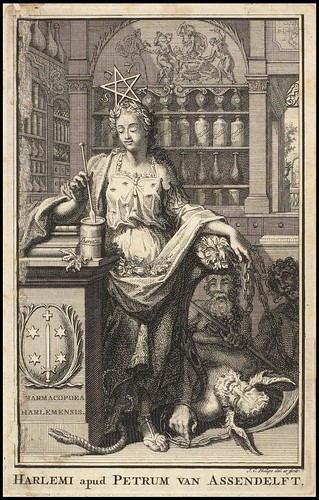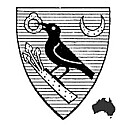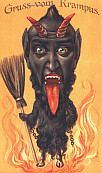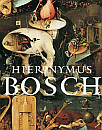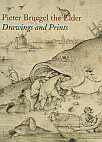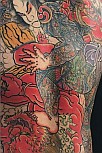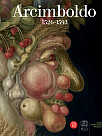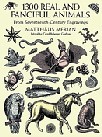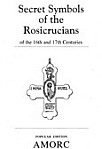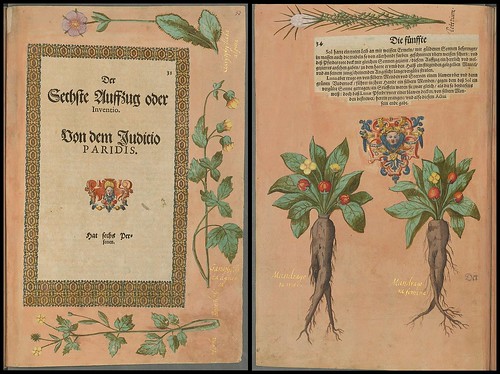
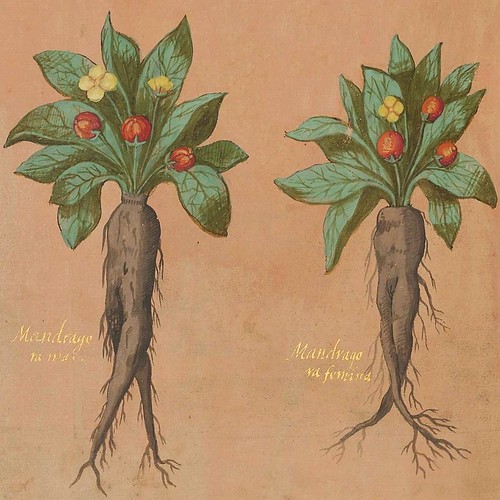
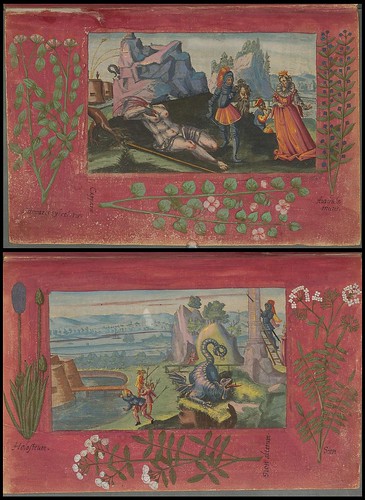

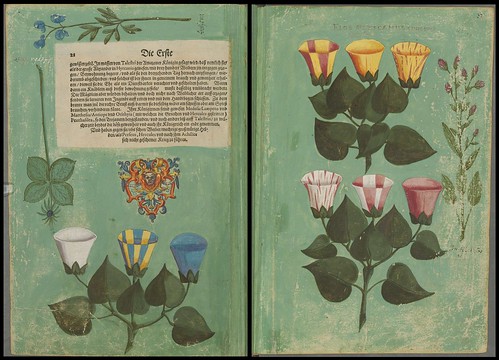
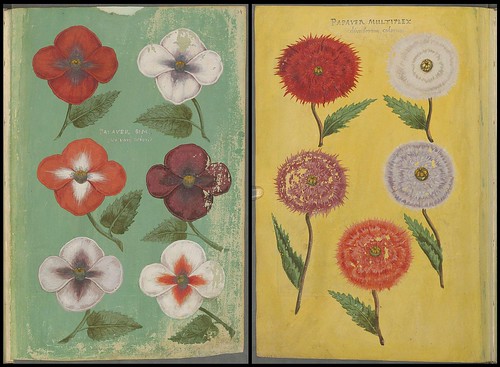
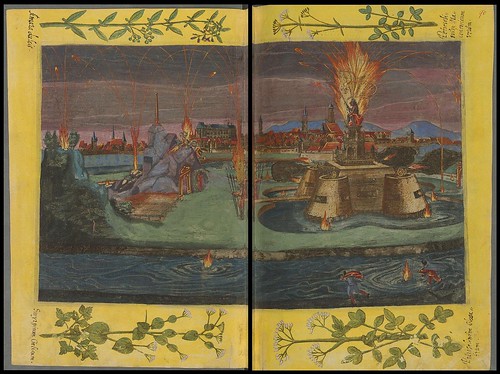
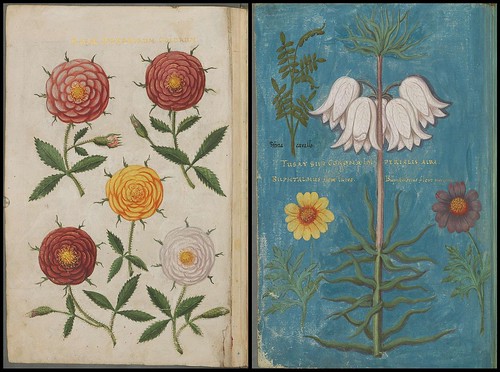
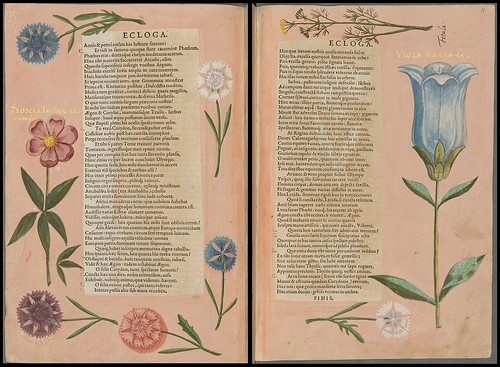
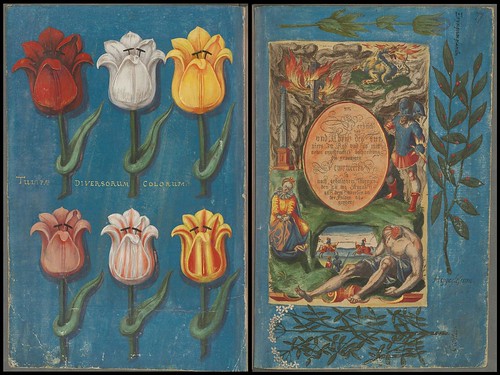
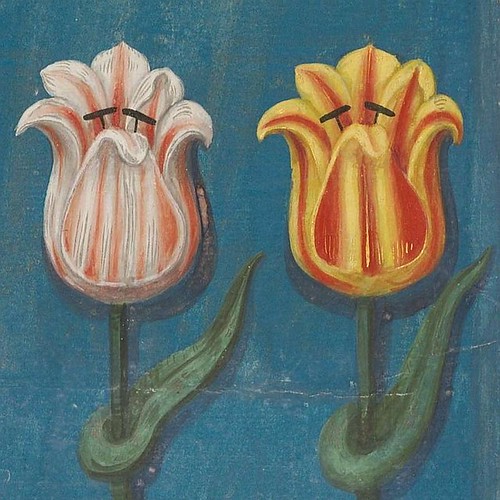
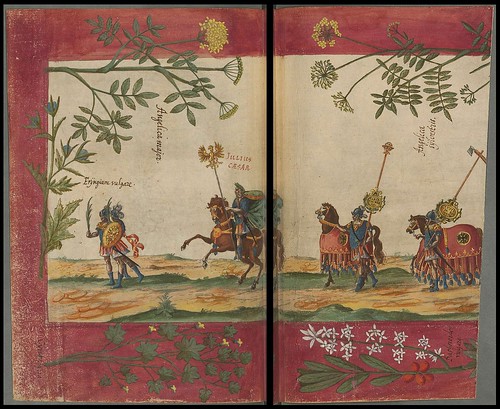
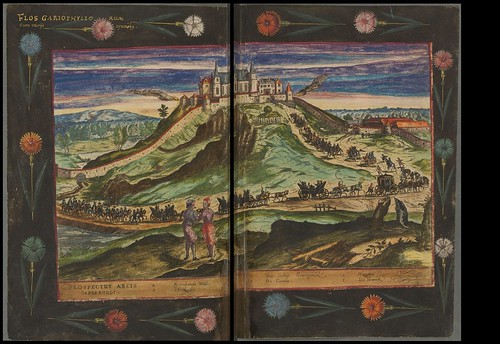
A couple of months ago, we saw an album of hand-coloured allegorical illustrations about a festival held on the occasion of the baptism of Princess Elizabeth of Hessen in 1596.
It turns out that there are three related works held by the Munich State Library. They are: BSB Cod.icon. 340 (we saw last time); BSB Cod.icon. 27(1 {the present botanical album} [translation] and BSB Cod.icon. 27(2 {I haven't had much of a look at this due to the present bandwidth problems, but it seems to be another allegorical festival work relating to an Essen royal parade}.
I *think* the present florilegium was painted onto pages from both of the Essen tournament works, hence making up a kind of scrapbook. The binding bears a date of 1606 and the volume is made up from pages out of the books from 1596 and 1598 by Wilhelm Dilich. The botanical artist is not known and their lush naturalistic watercolour flowers are accompanied by latin taxonomic names.
It was surely an eccentric editorial choice to paint beautiful flowers alongside such striking imagery as beheadings and dragons!
Friday, July 04, 2008
Scrapbook Florilegium
Thursday, July 03, 2008
Grab Bag
Engraving by Jan Caspar Philips, 1750. Spliced together from screencaps and sourced from the North Holland Archives. There's precious little information online about this Dutch engraver (nor this engraving) who is best known for a series of portrait plates made of senior Mennonite Ministers.
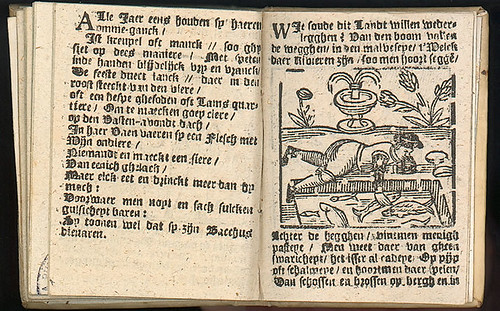
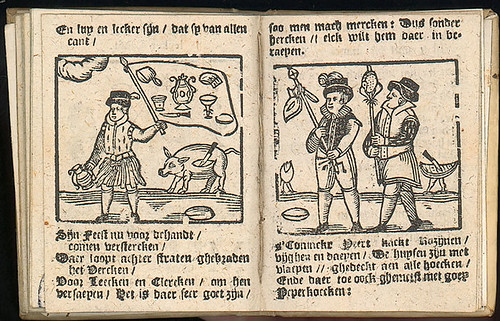

'Verhael met den Almanach..' is a very small 1692 folklore book by Jacob Mesens with a number of slightly absurd woodcuts (in the manner of le monde renversé), combined with a couple of poems. It is easily accessible from the Antwerp Library Archives.
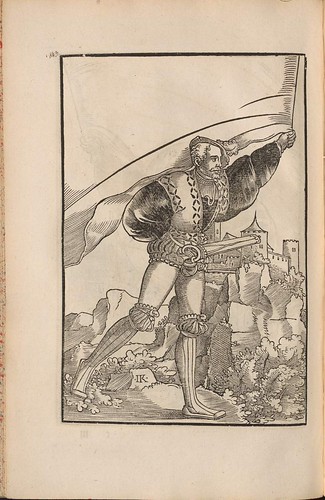

'Wapen. Des Heyligen Römischen Reichs Teutscher Nation' or Koebel's Wappenbuch (Coat of Arms book) is interesting because the heraldic symbols are all featured on flags - although perhaps not so obviously with the two example images - held aloft by the mercenaries known as Landsknechts (seen recently). Published in 1545 by Jacob Koebel, this rare wappenbuch features around one hundred and fifty full page illustrations (by Jacob Kallenberg - monogramme: 'IK') of the puffy shirt-wearing, armor-clad flag bearers; and in passing, I noted a subsequent edition from the late 16th century selling for ~€4000. The complete book is available online at the Bavarian State Library. [via Archivalia]
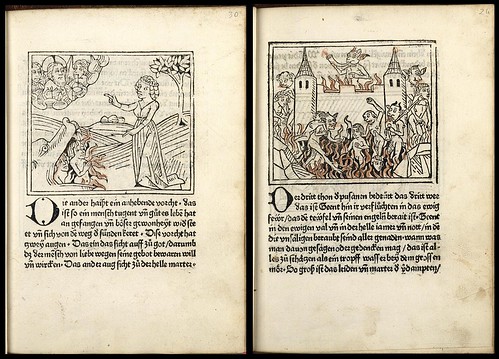
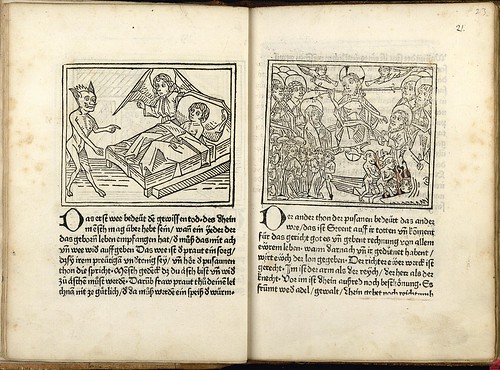
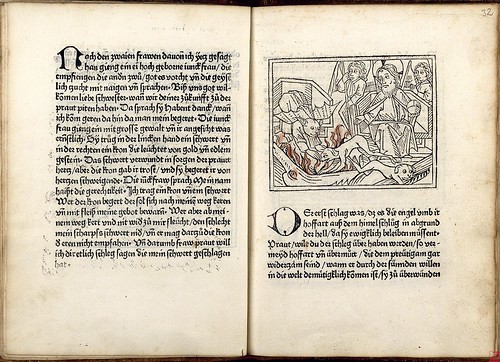
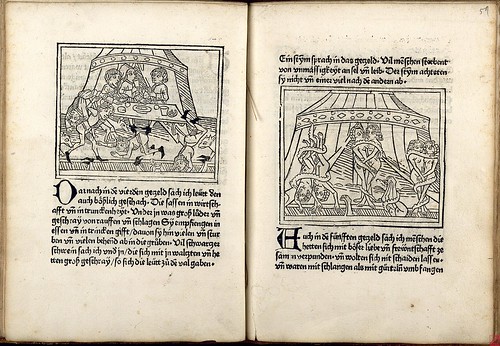
'Buch der Kunst dadurch der weltliche Mensch mag geistlich werden' (something like: Art book to help the secular man find spirituality). This incunabulum was published in Augsburg by Johann Bämler in 1477 and is as good a place as any for all your medieval woodcut devil and
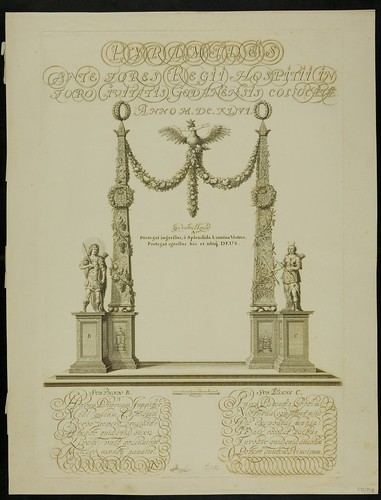
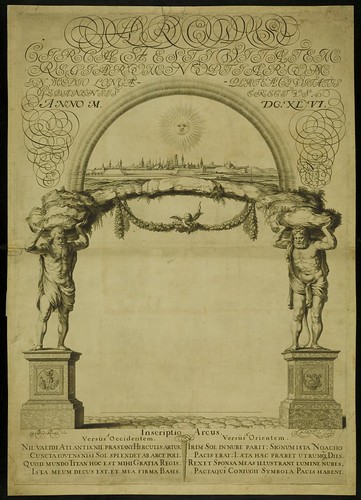
medio Longae Plateae civitatis Gedanensis erectus'
Description: Triumphal gate with Atlas and Hercules, built in Gdańsk in honour of Ludwika Maria Gonzaga.
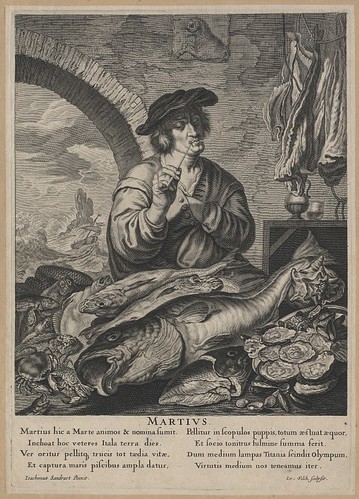
All these three illustrations, from 1646, were produced by Jeremiasz Falck, a Polish artist who worked all over Europe. The Martius illustration was designed by the great German Baroque artist, Joachim von Sandrart. I confess to having no clue as to the nature of those elaborate ornamental calligraphy prints but presume they were commemorative works, given the description of the 'Arcus Circa' design. A portrait of Ludwika Maria Gonzaga is actually among a small collection of illustrations by Falck hosted by the Polish Digital Library (put 'Falck' in the search box to return eight prints and a portrait of the artist).
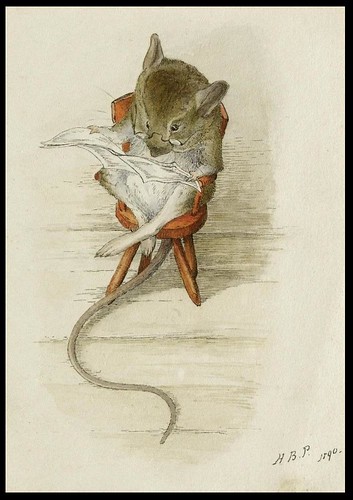
The latest Sothebys* catalogue (English Literature, History, Children's Books & Illustrations) lists a number of previously unknown original ink and watercolour sketches by Beatrix Potter. The bespectacled mouse illustration (1890) above, spliced together from screencaps, displays Potter's fondness for drawing mice reading newspapers, a subject which appears in a number of her works.
*[requires registration]
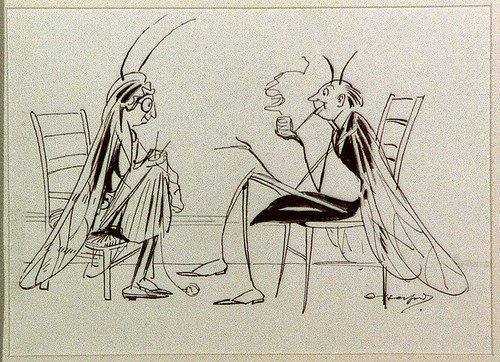
I have absolutely zero recollection and no notes in relation to this image. If anyone has any info. about the repository, artist or date, please let us know.

I left the title tag with 'Russian Cthulu'* in deference to the Babs71 LiveJournal site owner's entry. They photographed this map in a local shop in Russia. It's trilingual (Finnish + Swedish as well as Russian) and was probably produced in Scandinavia. It was made after 1900* (the Paris Exhibition is noted on the map). Some of the caricatures appears to be non-contemporary national symbols/people and some of the imagery has been lifted from previous joco-serious cartographic curiosities.
*Update: P-E Fronning comments:
"..it says on the map "Europe and the world's largest monarchy before its overthrow" so I guess either it is a call to overthrow the government or it is made 1917 or after."
Monday, June 30, 2008
Beached Whale
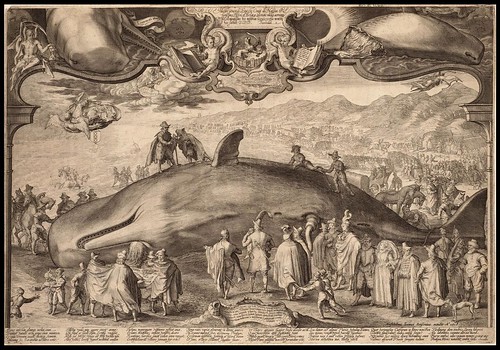

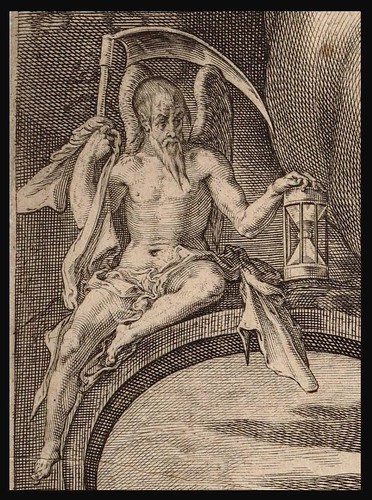

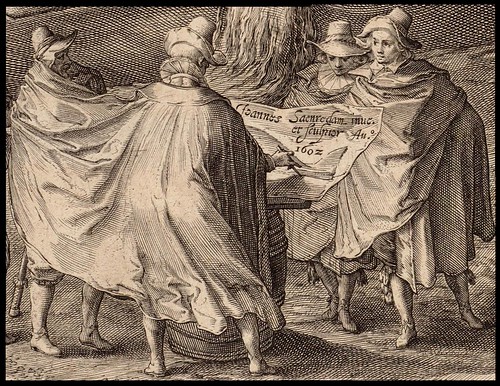

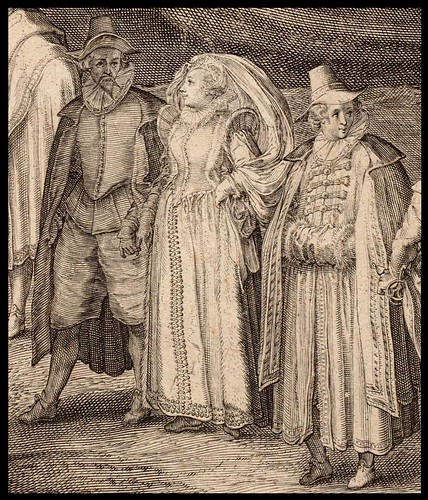
[There's no little irony attached to finding out that my access to the web was throttled back by the ISP to 64kb/s (!) at exactly the same time as I'm piecing together beached whale images (from screencaps). A further bittersweet edge involves the transfer speeds and monthly broadband allowance for the service having actually increased in the previous month. One leads to the other of course: greater access begats an itchy trigger finger, more prone to click on video links that would ordinarily be avoided. My own 'beached' status is set to continue for the next ten days, so some truncated posts - as this one essentially is - may appear. At least I have a store of locally saved material from which to sample, so it's just the uploading pain that will be the limiting factor. In any event...]
While looking around the new North Holland Archive site, I happened upon the above beached whale engraving, made by Jan Saenredam in 1602 (this particular print was published in 1618). Here is the direct link to the zooming page. The title is recorded as: 'Illustri generoso Ernesti Comiti de Nassau. fortissimo Horoi, et Belgicae Liberta.is vindici acersimo D. suo clementissimo hoc monstrum [...] monstro so ho faculo D.D.D. J. Saenredam'.
This elaborate illustration conveys a profile of allusions beyond the mere narrative of the whale's beach landing. It belongs to a narrow genre of disaster allegories - of which Saenredam's print is perhaps the finest example - that found a receptive audience, chiefly in the 17th century.
Beached whales were regarded as significant phenomena, not because Early Modern proto-environmentalists galvanised a populist empathy for so striking and unusal a loss of life, but because beachings were a part of the folklore, seen as bad omens and associated with disasters and tragedies. Of course, hindsight offers both the superstitious and artist alike an opportunity to indulge in historical revisionism, so that a causal link back from a series of tragedies could be established to the rare appearance of such a great sea 'monster' on land.
Saenredam presents the dominating scene with a journalist's eye for reporting. The main character, our sperm whale, did actually wash ashore in December 1600 in the vicinity of the towns of Beverwijk and Wijk aan Zee* and Saenredam did definitely visit the location. Ernst Casimir, Count of Nassau-Dietz and hero of the war against Spain, appears centre stage with plumed hat in front of the whale, his back to us, armed with a handkerchief to protect his refined sensitivies against the beast's odour (he visited the scene two weeks after the whale became stranded). He is accompanied by an entourage who are recorded in fine detail (the single finger 'hand-hold' between one of the couples is a delicate touch: the last image detail above).
People are inspecting the carcass and the blow hole as the townsfolk understandably stream down to the shoreline from surrounding hills and a large crowd gathers to revel in the momentous occasion. In the foreground, men stride to work carrying whale axes on poles. The artist himself appears in the scene, just below the whale's jaw, where he draws the spectacle behind a cloak windbreak, using a barrel for support. Perhaps the scene has been a little embellished to give prominence to the dignitaries, but otherwise it all appears fairly natural and not out of keeping with what one would expect to see.
The upper third of the print is a different story entirely. In a series of slightly obscure vignettes, Saenredam alludes to other circumstances that are associated with or thought to be attributable to the whale's appearance on the coast. In the far background we have both solar and lunar eclipses which occurred shortly after the whale's appearance and, like comets and other irregularly occurring natural phenomena, were seen by contemporary observers as harbingers of doom. An unhappy face has been caricatured onto the moon(s).
An angel bearing the coat of arms of Amsterdam, watched over by the ominous looking father time, is shot by death and falls from the sky, and may represent the epidemic of plague fatalities in the capital in the first couple of years of the 17th century. In the cartouche below the lion, the cartographic wind symbol can be seen blowing the land away in reference to an earthquake that occurred at the beginning of 1602. The latin verse at foot of the print is by the humanist poet, Dirk Schrevel, and although I can't read it, phrases like 'mortalibus omen' and 'monstro portenditur' appear in keeping with the overall gloom of the imagery.
The print holds a further dimension of interest because Saenredam was a student of the great Haarlem engraver, Hendrick Goltzius, whose 1598 depiction of a beached whale established the form as a legitimate artistic subject. Goltzius misinterpreted the animal's appearance however, believing that the lateral fin was actually an ear, which he sketched as more stunted and closer to the head than is true. That same stylised approach appears in the image immediately below by Jacob Matham, the stepson of Goltzius. Although Saenredam would have seen the Goltzius/Matham engravings, his own original version turned out to be an improvement over his master's approach.
Spaightwood Galleries have a biography and selection of prints by Jan Saenredam.
Otherwise, information for this entry was gleaned from the North Holland Archive, Rijksmuseum, MoMA and British Museum Prints database (origin of the Matham print).
I had hoped to retrieve a few more disaster prints - relating specifically to the omen-like genre - from around the traps but the current bandwidth problem has dampened my enthusiasm. Instead, I've included a few related images from NYPL, who thankfully allow hotlinking to their smaller images these days - click through on those to get to larger versions at the host site. The final print below is particularly odd: a whale entombed in an iceberg!! I looked high and low using all permutations of search terms I could muster without finding any information. I conclude that this is a pre-photoshop hoax or shaggy sea tale.
"The beached sperm whale on the shore near Beverwijk; the whale is surrounded by diminuative figures and there is an encampment near the dunes; a dog stands on the back of the whale and a boy crawls into the gaping mouth; in the foreground a food seller approaches a finely attired couple. 1601." {by Jacob Matham}
[In other words, although this print is meant to be the same beached whale as Saenredam's, it was actually modelled after the inaccurate version by Hendrick Goltzius from 1598.]
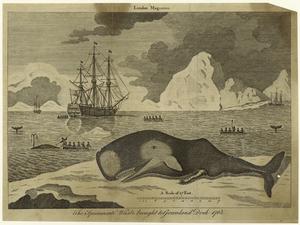
IN: London Magazine
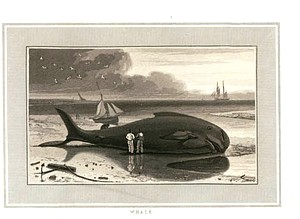
IN: 'Interesting Selections from Animated Nature', 1807-1809.
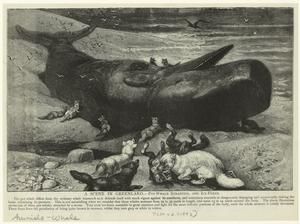
IN: 'The Picture Magazine', 1893-1896.
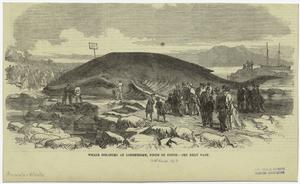
IN: Illustrated London News, 1842.
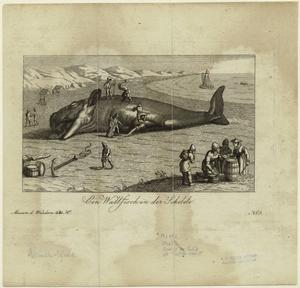
"Whale caught by 1603 at Dutch coast" (written in margin)
IN: 'Museum des Wundervollen..' by J Bergk, published 1869.
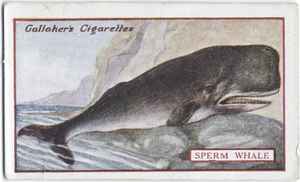
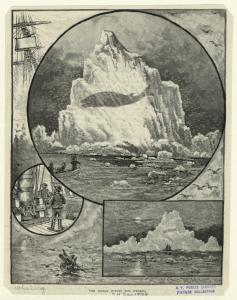
by Geo. R Halm, 1884.
